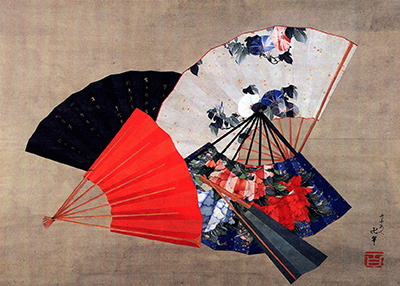Hokusai
Five Fans by Hokusai
Katsushika Hokusai’s Five Fans is a Japanese painting produced in 1849. Hokusai was a master print-maker of the Ukiyo-e (“pictures of a floating world”) tradition in Japan. Five Fans, however, is a painting produced in ink and colour on silk.
Hokusai described himself as the “mad painter”, and he experienced a long career as a Ukiyo-e artist, print-maker and expert on Chinese painting. He adopted numerous pseudonyms over his extensive career, which have covered the different “periods” and styles of his work. At the time Five Fans was released, he referred to himself as “Kyūjū Rōjin Manji hitsu” (Brush of Manji, old man of ninety). It was one of the last paintings he produced before his death that same year (1849).
As one of Hokusai’s last works, Five Fans is an interesting still life portrait of an iconographical symbol of Japanese culture—the folding fan, or sensu—painted with reference to Western artistic styles, forms and concepts. It was produced with brush and ink, and manages to capture the soft and subtle elegance of the handheld fan; delicately and intricately detailing the fan’s paper construction and design. In staging a still life of the fan’s various stages of opening on a flat 2-dimensional plane, Hokusai is able to bring the “floating” life of his Ukiyo-e style to the world of brush and ink.
Hokusai is regarded as Japan’s foremost artist, having produced works of vivid imagination and quality up until his death at the age of 90. His works are widely received as reflective of Japanese art and print-making, with his famed book Thirty-Six Views of Fuji, and its most celebrated print The Great Wave, continuously being exhibited, printed and reproduced as iconic representations of Japanese culture.
Through all his works, Hokusai has consistently shifted his subject and interests, engaging with such disparate themes as landscapes and the still life, and with narrative perspectives that have included folklore, fairy tales and historical anecdote. Through all of these works, Hokusai’s personal beliefs, spirituality and artistic philosophy have been imparted, and continue to inspire practitioners of the Ukiyo-e and woodblock print-making.
